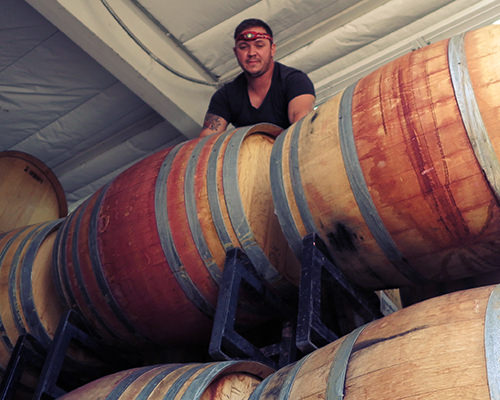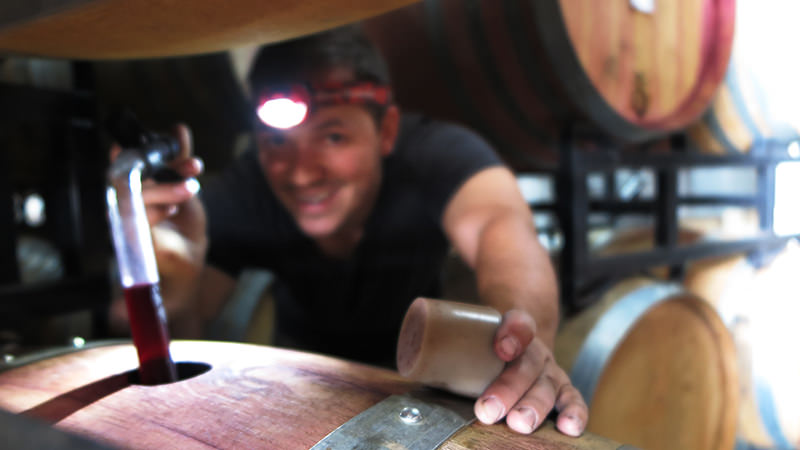What’s it really like to work in the wine business? Is it all glamorous private tastings, fancy lunches, and lush vineyard tours? In most cases, absolutely not. This week, I caught up with former New York Sommelier Christopher Walsh, who made the jump to wine production in 2014.
Today, Walsh works as a cellar hand, the proverbial “cellar rat,” scurrying between barrels day after day at Easton Wines, a family-owned winery in rural California. Though the term cellar rat often conjures images of dank, moldy European cellars and lots of tasting, the job rarely takes place in a classic underground cellar, and is more likely to involve removing mold than reveling in it. And as Walsh pointed out, there’s shockingly little tasting.
VinePair: What’s the best part of your job?
Walsh: The best part is working with so many stages of wine. I can really see how things come together, and see what factors really influence a wine. My favorite part of it all is watching fermentations – you start with grape juice, then it fizzes a little, then a lot, and then the smells all start changing. It’s really fun to see the wine come together, and see how alive it is.
VinePair: What’s the worst part?
Walsh: Working in the cellar is ridiculously detail-oriented, which means a lot of my day-to-day jobs are really tedious, like topping barrels. When there’s nearly 1,000 barrels in a room, you know its going to be a long day of climbing barrel stacks. Oh, and bottling lines. Wanna know what it feels like to be a robot? Bottle 3,000 cases in a day.
My worst enemy on the job is fruit flies. These tiny, annoying little gnats–if its warm, you have them and it doesn’t matter how clean it is. They will come. I also have a love-hate relationship with the black widow spiders that come to eat the flies, though I have a “live and let live” policy.
VinePair: What does your average day look like?
Walsh: It could be a lot of things – cellar rats are basically wine mechanics. I might be filling barrels, prepping and maintaining barrels so they don’t leak, transferring wine from tank to barrel, and running lab analysis on fermentations. Plus bottling.
VinePair: Any secret tasks you didn’t expect to be tackling?
Walsh: Lots, but the best is ‘Bung Patrol.’ Bungs are the large silicon corks that we close the barrels with, and sometimes a fermentation sends them flying out of the barrel with a ‘POP!’ Every couple of days we go hunting for them and the barrels that they flew from.
VinePair: Do you have a favorite nickname for your job?
Walsh: Cellar rat is actually a really accurate term. We scurry around, climb on stuff, check things out, and make messes. Unlike rats though, we actually clean up our messes. Although I do like the title Barrel Monkey.”

VinePair: Is there anything glamorous about cellar rat-hood?
Walsh: Nothing I would’ve formerly considered glamorous. I don’t wear suits and ties anymore, and usually I come home covered in some sort of wine solution. It’s certainly not an Under the Tuscan Sun experience, it’s more like smelling every barrel, and there are thousands.
VinePair: Would you go back to the service side of the industry?
Walsh: I don’t think so–I really wanted something more. I wanted to make something. On the service side, you get to taste so much amazing wine, and I miss that, and seeing people enjoying it. But I don’t think I’d give up having my hands on the grapes now.
VinePair: Do you still taste a lot of wine in the cellar?
Walsh: Not really. We do taste the wine as it ferments, and during other stages, but smell is our focus. We smell and smell and smell for faults like bacterial growth and volatile acidity–basically the things we don’t want in our finished wines.
VinePair: At the end of a long day, what’s your go-to drink?
Walsh: Usually we’ll grab a beer after a long day, but if I could drink anything, it’d be white wine that I don’t make–probably dry German Riesling.

